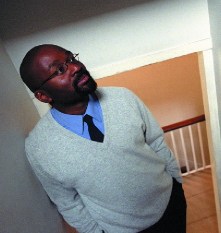In 1996, Blockbuster Video opened its first store in Harlem, on 125th Street. The outlet soon became the third-highest-grossing Blockbuster in all of New York City. "People were flabbergasted at how much money it made," says cultural anthropologist John L. Jackson Jr. "There was no major video chain in Harlemmom-and-pop stores rented videos, but historically, the community had been underserved." In other words, many who should have known better were missing the reality of Harlemin this case, its immense business potential.
 |
| Cultural anthropologist, filmmaker, and Harlem ethnographer John Jackson. |
| Photograph by Stephanie Mitchell / Harvard News Office |
Jackson's research, for example, undermines the widely held view of black America as two geographically and socially segregated communities, made up of an underclass and a middle class. Drawing on dozens of interviews with Harlemites and field observations recorded while he lived there for four years as a Columbia graduate student, Jackson describes the prevalence of family and friendship networks that straddle social-class lines. Consider Paul, a 31-year-old architect who regularly plays one-on-one basketball with Tim, an old friend who still lives in the low-income housing complex in Brooklyn where they both grew up. Or take a retired educator, Mrs. Joseph, who makes a point of finding ways to connect with some of the streetwise young men in her Harlem neighborhood, whether by inviting them to dinner, or going to church together, or just asking to be escorted home from the subway at night. Jackson offers many examples that contravene the "two-world model" of social-class isolation among African Americans. Yes, class stratification exists, but "If that's the only horse you're betting on," he says, "you're not understanding black communities."
This concept also has relevance to social policy. "The tracks are already there, across class lines," says Jackson. "This could translate into jobs and education. These networks might provide a means of advancement and achievement, of benefit to folks at the lower end of the socioeconomic spectrum." For example, an African-American CPA might recommend a Harlem acquaintance for a support-staff job, or a high-school teacher might extend herself on behalf of an underprivileged student with exceptional promise.
Harlemworld's core argument is that class and race are not intrinsic attributes or categorical givens, but are "performative" (enacted) social facts. "The performative elementthe 'doing' of race and classis the very engine that gives these things life," Jackson explains. "Race and class don't exist as abstractions. One of the most useful ways to get at them is through social performances."
Consequently, he argues, it is misleading to "essentialize" race. "Race isn't a biological reality," he says, noting that all humans are ultimately of mixed heritage. "But many social scientists don't want to use the word 'race' unless they are talking about biology. Race is an important category; it's an extremely significant social fact. But everyone has a different perception of race and what it means for themit's so individualized, so contextually specific. Similarly, while there are class differences, people play with class. It's always Janus-faced: hard and fast, yet really supple."
Meanwhile, the face of Harlem itself is rapidly changing. During the past few years, it has become one of New York's "hot" neighborhoods, despite the fact that the prevailing opinion, as late as the mid 1980s, was that Harlem couldn't be gentrified because white New Yorkers were afraid to live there. But in the mid 1990s, "empowerment zone" legislation brought corporate capital uptown. Starbucks outlets began to appear amid older storefronts. "Today, 125th Street is noticeably different from the way it was in 1999, when I finished my fieldwork," Jackson says. "Housing prices are soaring, and folks who have been renting for dozens of years no longer find it easy to stay. It's a neighborhood that's there for the taking. This is really good housing stock, built for the white middle class who wanted to get uptown and away from the teeming city. Harlem is still an amazing piece of Manhattan real estate."
Much of that real estate will surely survive, and probably be rehabbed, but the same may not be true of the Harlem community. The arrival of a Magic Johnson multiplex in a neighborhood that had no movie theater, and the opening of the $66-million, 275,000-square-foot Harlem USA mall, with its Disney and Old Navy stores, surely signify. Jackson, an accomplished filmmaker, is currently exploring Harlem's gentrification in a documentary, Harlem Stories. It remains to be seen whether that film, and Harlemworld, will some day become part of a broader anthropological tradition: portraits of communities that have disappeared after their conquest by corporate commerce.
~Craig Lambert
John Jackson e-mail address:
jackson7@fas.harvard.edu





